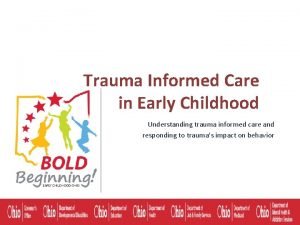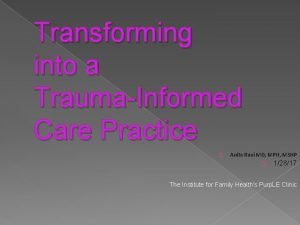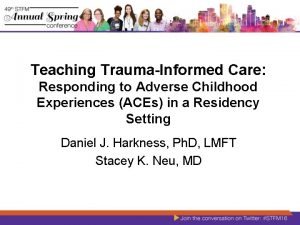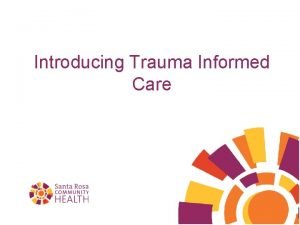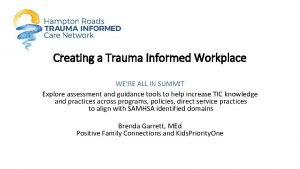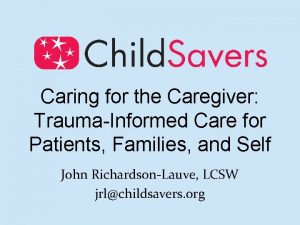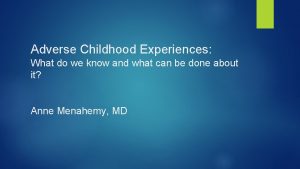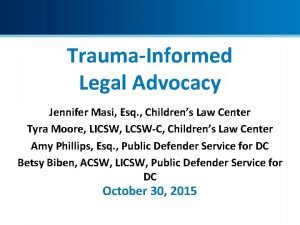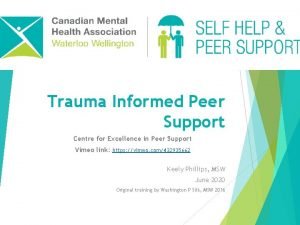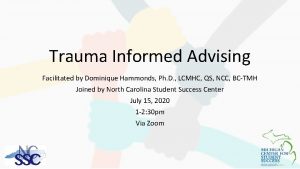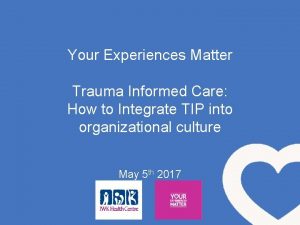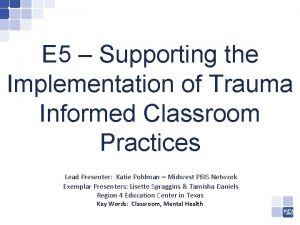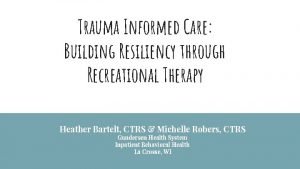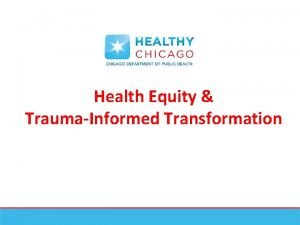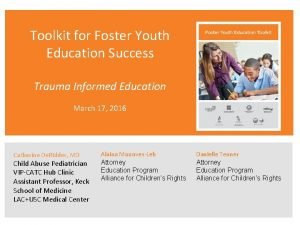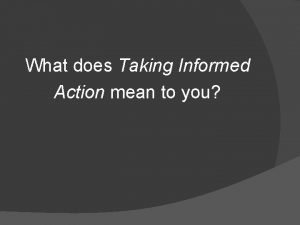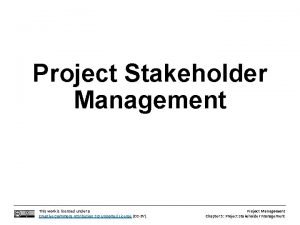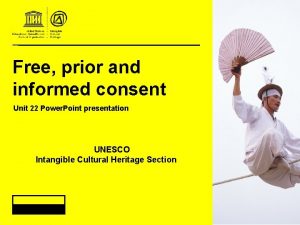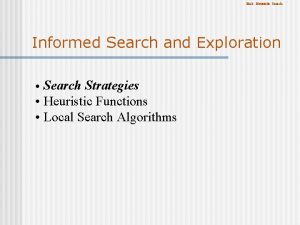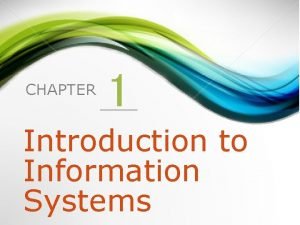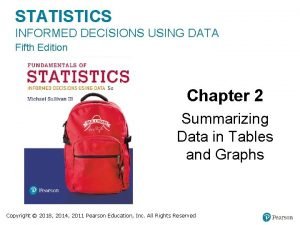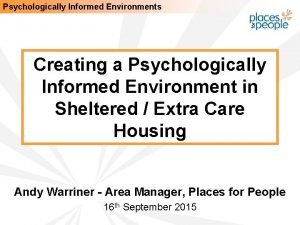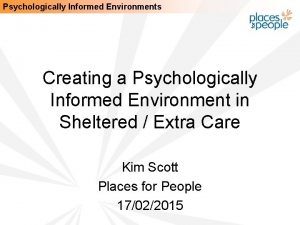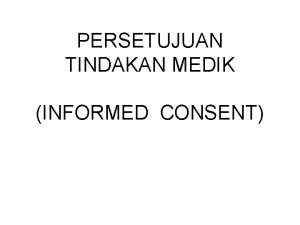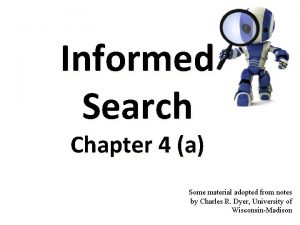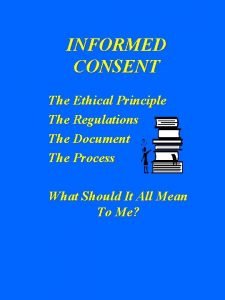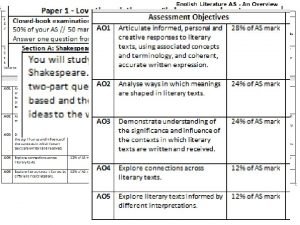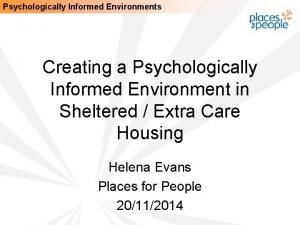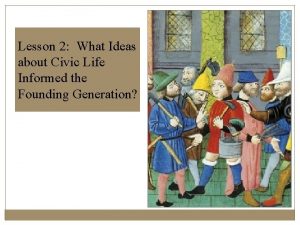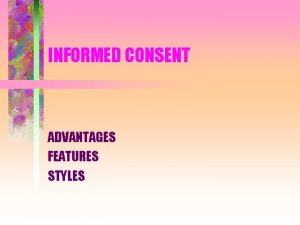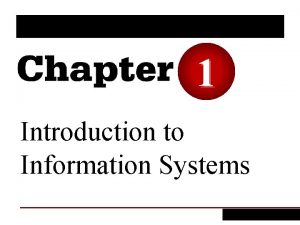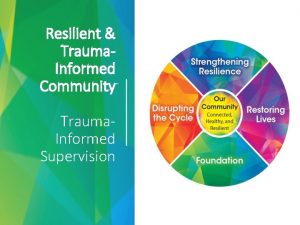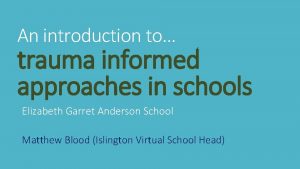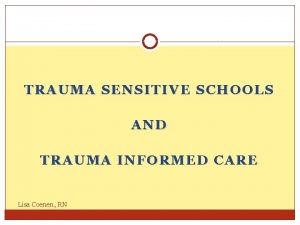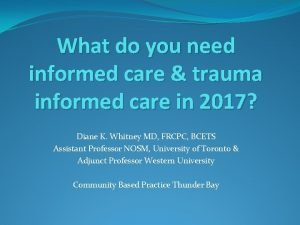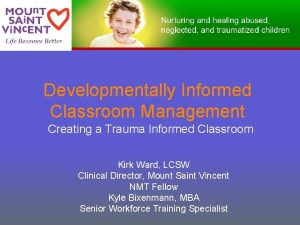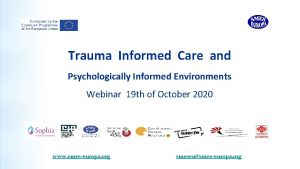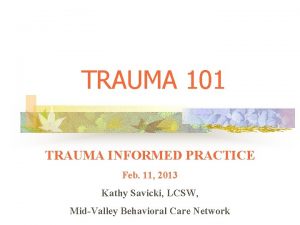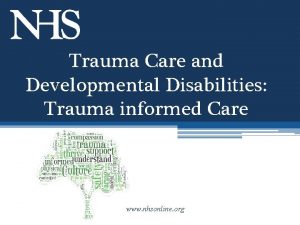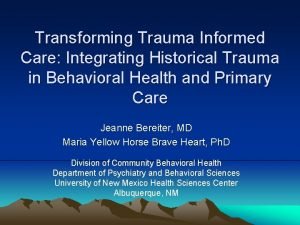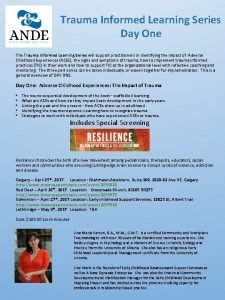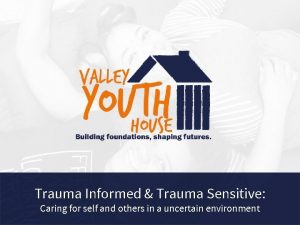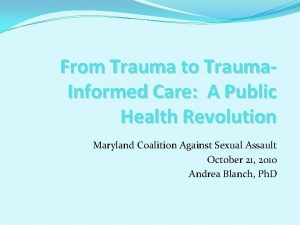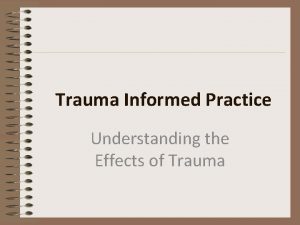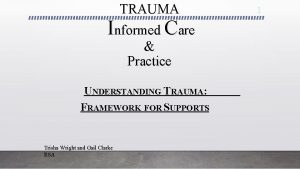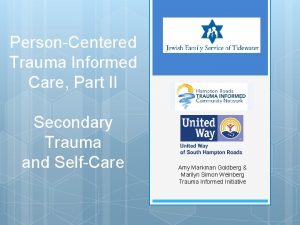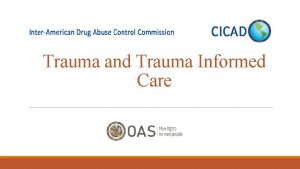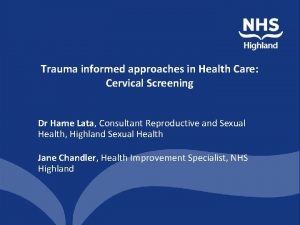An introduction to trauma informed approaches in schools














































- Slides: 46

An introduction to… trauma informed approaches in schools 4 th June 2018 – St Mark’s Primary School, Islington Matthew Blood (Islington Virtual School Head) Michael Reeves (Islington CAMHS link to Virtual School)

Aims of the morning Ø to establish a shared understanding of “complex trauma” and how this impacts on brain development (PRESENTATION) Ø to consider how complex trauma affects children in school (DISCUSSION AND PRESENTATION) Ø to begin exploring trauma-informed approaches to support learning for vulnerable children (CASE STUDY WORKSHOP)

First rule of trauma-informed work – be aware of and attend to our own feelings if we want to be effective with children This topic can feel difficult at times – take a break if you need to Looking after ourselves If people are sharing experiences we will listen, be respectful and keep it in the room Where is my energy at? About to blow – can’t think at all Unsettled/ distracted Calm/ focused/ ready to learn (Just Right) Cool and switched off https: //www. brighton-hove. gov. uk/sites/brightonhove. gov. uk/files/Just%20 Right%20 Pack%20 leaflet. pdf

Why are we bothering with this? Trauma can impact on a child’s body, brain, memory, emotions, relationships, learning and behaviour. If we learn about the impact of trauma on a child we can reduce the chance of a child being misunderstood - this in turn reduces stress for staff and pupils

damage What does the word suffering trauma make you think of? ordeal shock

“A psychologically distressing event (s) that is outside the usual range of human experience often involving a sense of intense fear, terror and helplessness” (Perry 2011) Any experience that threatens life or physical integrity and overwhelms an individual’s capacity to cope: Perception is more important than reality Can be an acute (one off) event or chronic (over time) What is trauma? Trauma is not the event itself, but rather a response to a highly stressful experience in which a person’s ability to cope is dramatically undermined.

c a m u a r t x e l p om

What is complex trauma? Complex trauma is a response to overwhelming negative life events which happen to children over a period of time, often within their own attachment relationship, such as neglect, psychological maltreatment, attachment separations and impaired caregiving systems. (van der Kolk, 2005) If there is no safe adult to help a child process what is happening the experience is more likely to have a traumatic effect.

Situations that may be considered traumatic Physical or sexual abuse Emotional maltreatment Abandonment Neglect Death or loss of a loved one Violence from a caregiver Witnessing domestic violence Poverty Bullying Witnessing or experiencing community violence Witnessing police activity Imprisonment of a close relative Living in chronically chaotic environments Poor housing

Adverse Childhood Experiences increase children’s exposure to trauma



How childhood trauma affects health across a lifetime – the ACE study Nadine Burke Harris 5: 38 – 9: 30 https: //youtu. be/95 ov. IJ 3 ds. Nk? t=338

How does complex trauma affect a child’s development and ability to learn and relate in school?

How a child's brain develops through early experiences https: //www. youtube. com/watch? v=h. My. DFYSk. ZSU

https: //www. youtube. com/watch? v=4 -tc. KYx 24 a. A&t=4 s

Triune Brain (Maclean) 3 parts: evolved responding to evolutionary need) Thinking (Neocortex) Newest SLOWEST Cerebral cortext, forebrain Seat of reason Emotional (Limbic system) Hippocampus, amygdala, hypothalmus Set of emotions Base (Reptilian brain) Hindbrain Oldest FASTEST Brain stem, physical survival, breathing, excretion, blood flow, temperature, other autonomic functions




What helps the child to survive? The brain adapts and uses a fight/ flight/ freeze/ flop response at times when there appears to be no need - these adaptations can look like behaviour problems in school ISLINGTON TIPPPS ARC DEVELOPED BY BLAUSTEIN AND KINNIBURGH Survival trumps everything Assumption of danger - it is about ‘felt safety’ not necessarily actual safety Rapid mobilisation in the face of perceived threat – fight, flight or freeze Self-protective stance Development of alternative strategies to meet developmental needs – ‘how have these young people learn to get by? ’ e. g. controlling, provoking expected response/seeking out conflict, avoiding help -seeking, unhelpful attempts to self-sooth, dissociation, sensation seeking etc Many distressing behaviours represent the child/adolescent’s attempt to cope

We all define danger differently Our individual filters – based on experience - guide our interpretation of the world. ISLINGTON TIPPPS ARC DEVELOPED BY BLAUSTEIN AND KINNIBURGH

There are only a few possible responses to danger: fight, flight, freeze/flop ISLINGTON TIPPPS ARC DEVELOPED BY BLAUSTEIN AND KINNIBURGH *and ALL of them REQUIRE a surge of arousal.

Behaviour is generally functional and makes sense in the context it which it developed - but may not in other contexts/ relationships ISLINGTON TIPPPS ARC DEVELOPED BY BLAUSTEIN AND KINNIBURGH


Our ability to shift from “Survival Mode” (survival-based behaviors) to active engagement (learning brain) is impacted by our internal and external resources Affect management Trust Frustration tolerance Ability to read others ISLINGTON TIPPPS ARC DEVELOPED BY BLAUSTEIN AND KINNIBURGH Problem-solving ability Social connection and support Biological vulnerabilities

Trauma’s dual influence on development Prioritization of those domains of skill / competency / adaptation which help the child survive their environment and meet physical, emotional, and relational needs De-emphasis of domains of development which are less immediately relevant to survival BLAUSTEIN & KINNIBURGH, 2010; KINNIBURGH & BLAUSTEIN, 2005

While kids are getting really good at survival, what are they not getting? CURRICULUM - BLAUSTEIN

Children often have trouble with relationships, boundaries, empathy and social isolation Living in survival mode over a period of time means that. . . Physical health and development is impaired – sensorimotor/ coordination/ medical/ somatic When triggered, the “feeling” brain dominates the “thinking” brain so children struggle to identify and label feelings and communicate their needs

Dissociation: a child may experience amnesia and impaired memory Cognitive ability may be delayed – eg. problems with focus, processing new information, language development, planning and problem-solving and. . . Children can struggle with self concept, body image, low self-esteem, shame and guilt Behavioural control can be an issue – difficulty controlling impulses, oppositional behaviour, aggression, disrupted sleep and eating patterns, trauma re-enactment


Young children (0 -5) Key developmental tasks Trauma’s impact Development of visual and auditory perception Sensitivity to noise Recognition of and response to emotional cues Attachment to primary caregiver Avoidance of contact Heightened startle response Confusion about what’s dangerous and who to go to for protection Fear of being separated from familiar people/places ISLINGTON TIPPPS ARC DEVELOPED BY BLAUSTEIN AND KINNIBURGH

School-aged children (6 -12) Key developmental tasks Trauma’s impact Manage fears, anxieties and aggression Emotional swings Sustain attention for learning and problem solving Control impulses and manage physical responses to danger ISLINGTON TIPPPS ARC DEVELOPED BY BLAUSTEIN AND KINNIBURGH Learning problems Specific anxieties and fears Attention seeking Reversion to younger behaviours

One in four children will have experienced developmental trauma: affecting their behaviour and ability to learn ISLINGTON TIPPPS ARC DEVELOPED BY BLAUSTEIN AND KINNIBURGH

How ACEs make school harder (Van der kolk – ‘the body keeps the score’) Prevalence of indicators of negative well-being, by number of adverse childhood experience (12 -17) Measure of well being 0 ACEs 1 ACEs 2 ACEs 3+ ACEs High externalizing behavior 18% 26% 33% 41% Low engagement in school 25% 33% 44% 48% Household contacted due to problems at school 13% 23% 31% 38% Grade repetition 6% 12% 14% 21% Does not stay calm and controlled 24% 34% 40% 44% Does not finish tasks started 27% 36% 44% 49% Diagnosed with a learning disability 9% 13% 16% 23% Fair or poor physical health 2% 4% 4% 6%

https: //www. youtube. com/watch? v=Koqa. UANGvp. A

TRAUMA IN THE BODY Complex trauma often has multi-sensory impact, especially if trauma occurs in the pre-verbal years when memories will be held in the body and the limbic system of the brain, not the conscious part. When the amygdala is having a sense memory, it won’t let the conscious part of the brain know – so the trauma-trigger will be outside of conscious awareness. The intensity of a child’s distress can be an indicator that the distress is trauma related.

Loss of control Feelings of vulnerability or rejection Common triggers for traumatised children loneliness Confrontation, authority or limit setting Sensory overload (too much stimulation from the environment)

Tr n i s r e igg s a l c e th ? m o o r s

What are we aiming for in our work with What is the fruit that we are hoping to seechildren? in the children we work with or what hopes do we have for them on reaching adulthood? – eg. wellbeing/ achievements/ relationships? What does the child need to be able to do to achieve these goals/ outcomes? fruit/ leaves trunk and branches Child: seed of potential What does the child need to believe about himself/ herself to develop these skills? And what kind of approach to threat/ challenge does he / she need to have? What kind of care does the child need in order to develop these beliefs and ways of responding? root system soil


Physical and emotional distress looks like: Poor control of emotions Shutting down Unpredictable / impulsive behaviour Difficulty controlling behaviour Over/under-reacting to stimuli (bells, touch, looks, sudden movements, lighting…) ISLINGTON TIPPPS ARC DEVELOPED BY BLAUSTEIN AND KINNIBURGH Resisting or significantly unsettled by transition and/or change Poor attention, memory, cognition, problem solving, planning Reduced ability to focus, organise, process information Overwhelming feelings of frustration or anxiety

Traumatised children may: Expect to be hurt or rejected Have bodies that feel out of control Have feelings too overwhelming to manage Lack age-appropriate coping strategies Lose access to higher cognitive functions when upset Shift moods and states frequently, and have behaviors that feel confusing. ISLINGTON TIPPPS ARC DEVELOPED BY BLAUSTEIN AND KINNIBURGH


Teaching children how the brain works at times of stress Daniel Siegel Hand Model – “Flipping your lid” https: //www. youtube. com/watch? v=q. FTlj. Lo 1 b. K 8 https: //youtu. be/a_h. Pelc. PRTg? t=38

How a child's brain develops through early experiences https: //youtu. be/h. My. D FYSk. ZSU? t=120
 4 r's trauma informed care
4 r's trauma informed care Lgbtq trauma informed care
Lgbtq trauma informed care 4 r's trauma informed care
4 r's trauma informed care 4 r's trauma informed care
4 r's trauma informed care Trauma informed icebreakers
Trauma informed icebreakers Trauma-informed workplace checklist
Trauma-informed workplace checklist Trauma-informed questions for clients
Trauma-informed questions for clients 4 r's trauma informed care
4 r's trauma informed care Jennifer masi
Jennifer masi Kobtion
Kobtion Libby bergman
Libby bergman Tina champagne sensory modulation and environment
Tina champagne sensory modulation and environment Trauma informed advising
Trauma informed advising Trauma informed parenting discipline
Trauma informed parenting discipline Trauma informed practice
Trauma informed practice Trauma informed physical environment
Trauma informed physical environment Trauma-informed care cheat sheet
Trauma-informed care cheat sheet Trauma informed practice
Trauma informed practice Trauma informed care for foster youth
Trauma informed care for foster youth Powerschool huntsville city schools
Powerschool huntsville city schools Safety reach and target schools
Safety reach and target schools Informed action examples
Informed action examples Stakeholder mapping exercise
Stakeholder mapping exercise Psychologically informed environment
Psychologically informed environment Power-interest grid
Power-interest grid Free prior and informed consent
Free prior and informed consent Informed (heuristic) search strategies
Informed (heuristic) search strategies An informed guess or assumption about a certain problem
An informed guess or assumption about a certain problem Informed and uninformed search in artificial intelligence
Informed and uninformed search in artificial intelligence You should seek to be an informed user of it because
You should seek to be an informed user of it because Statistics informed decisions using data 5th edition pdf
Statistics informed decisions using data 5th edition pdf Psychologically informed environments
Psychologically informed environments Psychologically informed environments
Psychologically informed environments Dasar hukum informed consent adalah
Dasar hukum informed consent adalah Informed search example
Informed search example Best first search
Best first search Http informed delivery usps
Http informed delivery usps Informed delivery campaigns
Informed delivery campaigns Ethical principles governing informed consent process
Ethical principles governing informed consent process Uninformed search examples
Uninformed search examples What is an informed personal response
What is an informed personal response Psychologically informed environment
Psychologically informed environment What philosophical ideas informed the founding generation?
What philosophical ideas informed the founding generation? Informed delivery campaigns
Informed delivery campaigns Advantages of informed consent
Advantages of informed consent Is a consultative function of the mis department.
Is a consultative function of the mis department. Decision making skills
Decision making skills
